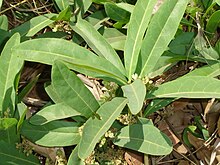This article includes a list of general references, but it lacks sufficient corresponding inline citations. (January 2011) |
| Gifblaar | |
|---|---|

| |
| Scientific classification | |
| Kingdom: | Plantae |
| Clade: | Tracheophytes |
| Clade: | Angiosperms |
| Clade: | Eudicots |
| Clade: | Rosids |
| Order: | Malpighiales |
| Family: | Dichapetalaceae |
| Genus: | Dichapetalum |
| Species: | D. cymosum
|
| Binomial name | |
| Dichapetalum cymosum | |
Dichapetalum cymosum, commonly known as gifblaar from Afrikaans, or occasionally by its English translation, poison leaf, is a small prostrate shrub occurring in northern parts of Southern Africa in the family Dichapetalaceae. It is notable as a common cause of lethal cattle poisoning in this region and is considered one of the 'big 6' toxic plants of cattle in South Africa. A 1996 estimate of plant poisonings in South Africa[1] attributes 8% of cattle mortality caused by poisonous plants to it. The majority (70%) of fatal cases are in Limpopo province, with 10% each in North West, Mpumalanga, and Gauteng. Fluoroacetate, the poison used to synthetically produce Compound 1080 used extensively in New Zealand, occurs in all parts of the plant and is responsible for the toxic effects shown.[2]
Toxic effects include vomiting, seizures, and an irregular heartbeat, and death can occur in as little as a few hours. This poison is known as "the poison that keeps on killing" because the toxin stays in the body after the animal dies, so if a predator eats the animal, the predator gets poisoned, and so on up the food chain. It can easily kill small mammals such as rats, earning it the name "ratbane"; it was banned for commercial use in the United States in 1972 by the Environmental Protection Agency.[3]
Dichapetalum cymosum was first recognised as toxic by the early Voortrekkers entering the Transvaal, who were probably alerted to its lethality by natives living in the region.[4]
- ^ Kellerman, T.S.; Naude, T.W.; Fourie, N.; Verwoerd, D.W. (1996). "The distribution, diagnoses and estimated economic impact of plant poisonings and mycotoxicosis in South Africa". Onderstepoort Journal of Veterinary Research. 63 (2): 65–90. hdl:2263/42595. PMID 8856758.
- ^ "Dichapetalum cymosum". The hidden Gifts of Nature. Retrieved 5 May 2008.
- ^ Stewart, Amy (2009). Wicked plants: the weed that killed Lincoln's mother & other botanical atrocities (1st ed.). Chapel Hill, N.C.: Algonquin Books. p. 235. ISBN 978-1-56512-683-1.
- ^ Steyn, D.G. (1928). "Gifblaar poisoning. A summary of our present knowledge in respect of poisoning by Dichapetalum cymosum". 13th and 14th Reports of the Director of Veterinary Education and Research: 186–194. hdl:2263/13676.
